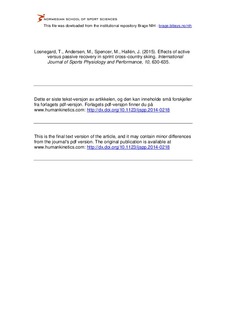| dc.contributor.author | Losnegard, Thomas | |
| dc.contributor.author | Andersen, Martin | |
| dc.contributor.author | Spencer, Matthew | |
| dc.contributor.author | Hallén, Jostein | |
| dc.date.accessioned | 2016-05-13T09:11:18Z | |
| dc.date.available | 2016-05-13T09:11:18Z | |
| dc.date.issued | 2015-07-05 | |
| dc.identifier.citation | International Journal of Sports Physiology and Performance. 2015, 10, 630-635 | nb_NO |
| dc.identifier.uri | http://hdl.handle.net/11250/2389388 | |
| dc.description | Dette er siste tekst-versjon av artikkelen, og den kan inneholde små forskjeller fra forlagets pdf-versjon. Forlagets pdf-versjon finner du på www.humankinetics.com: http://dx.doi.org/10.1123/ijspp.2014-0218 /
This is the final text version of the article, and it may contain minor differences from the journal's pdf version. The original publication is available at www.humankinetics.com: http://dx.doi.org/10.1123/ijspp.2014-0218 | nb_NO |
| dc.description.abstract | Purpose: To investigate the effects of an active and a passive recovery protocol on physiological responses and performance between 2 heats in sprint cross-country skiing. Methods: Ten elite male skiers (22 ± 3 y, 184 ± 4 cm, 79 ± 7 kg) undertook 2 experimental test sessions that both consisted of 2 heats with 25 min between start of the first and second heats. The heats were conducted as an 800-m time trial (6°, >3.5 m/s, ~205 s) and included measurements of oxygen uptake (VO2) and accumulated oxygen deficit. The active recovery trial involved 2 min standing/walking, 16 min jogging (58% ± 5% of VO2peak), and 3 min standing/walking. The passive recovery trial involved 15 min sitting, 3 min walk/jog (~ 30% of VO2peak), and 3 min standing/walking. Blood lactate concentration and heart rate were monitored throughout the recovery periods. Results: The increased 800-m time between heat 1 and heat 2 was trivial after active recovery (effect size [ES] = 0.1, P = .64) and small after passive recovery (ES = 0.4, P = .14). The 1.2% ± 2.1% (mean ± 90% CL) difference between protocols was not significant (ES = 0.3, P = .3). In heat 2, peak and average VO2 was increased after the active recovery protocol. Conclusions: Neither passive recovery nor running at ~58% of VO2peak between 2 heats changed performance significantly. | nb_NO |
| dc.language.iso | eng | nb_NO |
| dc.publisher | Human Kinetics | nb_NO |
| dc.subject | accumulated oxygen deficit | nb_NO |
| dc.subject | elite athletes | nb_NO |
| dc.subject | lactate reduction | nb_NO |
| dc.subject | repeated sprint | nb_NO |
| dc.subject | VO2max | nb_NO |
| dc.title | Effects of active versus passive recovery in sprint cross-country skiing. | nb_NO |
| dc.type | Journal article | nb_NO |
| dc.type | Peer reviewed | nb_NO |
| dc.subject.nsi | VDP::Social science: 200 | nb_NO |
| dc.subject.nsi | VDP::Social science: 200::Social science in sports: 330 | nb_NO |
| dc.subject.nsi | VDP::Social science: 200::Social science in sports: 330::Other subjects within physical education: 339 | nb_NO |
| dc.source.journal | International Journal of Sports Physiology and Performance | nb_NO |
| dc.identifier.doi | 10.1123/ijspp.2014-0218 | |
| dc.description.localcode | Seksjon for fysisk prestasjonsevne / Department of Physical Performance | nb_NO |
